Tsushima The main forces join the battle
Actions Russian admiral
Apparently, Z.P. Rozhestvensky saw a way out in not taking combat order until the appearance of the main enemy forces, and only then do the rebuilding. In this case, the Russian commander had a good chance to avoid “crossing T”, because X. Togo, until the very last moment, will not know the order in which the Russian squadron will be deployed. However, this decision had a downside. Given that May morning 14 visibility did not exceed 7 miles, Z.P. Rozhestvensky risked not having time to complete the rebuilding by the time the fire was opened.
Therefore, the Russian commander tried to hedge. When the Xumi Watching Izumi was seen on the squadron around 06.30, he did nothing, rightly believing that the main forces were still far away. The squadron continued marching, with its main forces moving in two parallel columns. But when the 3 battle squad appeared, ZP Rozhdestvensky, awaiting the imminent appearance of the battleships H. Togo and the armored cruisers H. Kamimura, orders the right column to increase its speed from 9 to 11 nodes. Thus, the right column gradually overtook the left, reducing the time required for rebuilding into a battle line - however, for the time being, from the side this maneuver was poorly seen and gave no idea what exactly the Russians started.
But time passed, but the main forces of the Japanese were not. The right column advanced strongly, and Z.P. Rozhdestvensky could only reorganize into the wake. At this moment, a short exchange of fire with the Japanese cruisers arises, and contact for some time was lost. Taking advantage of the lack of observation, Z.P. Rozhestvensky is trying to reorganize from the wake column to the front line. This made sense, since the intelligence officers probably had to report to Kh. Togo with the formation of a Russian squadron, but then the Japanese commander was expecting a small surprise.
But this surprise was not asked - at the time of the start of the execution of the maneuver, the Japanese cruisers appeared. Then Z.P. Rozhdestvensky orders the 2 squad to cancel the maneuver, and his 1 squad, made up of 4 squadron battleships of the Borodino type, returns the front to wake down. As a result, the Russian squadron once again moves in two parallel columns, and the only difference is that if Oslyabya and the 2 combat unit were in the right column in the morning, into the wake of the 1 armored squadron, now he headed the left column.
In other words, Z.P. Rozhestvensky again rebuilt his ships into a non-combat order, from which, however, he could quickly turn both into a front line and into a wake column. What happened next?
And what did H. Togo do?
Japanese admiral received a message about Russian navy at approximately 04.30. A little more than an hour and a half later he weighed anchor, and on 06.07 led his main forces to intercept. H. Togo was about to begin a general battle near Fr. Okinoshima, but how? A comprehensive answer to this question is given by the Japanese admiral himself, in his official report on the battle:
Why precisely left? Obviously, made up of the Oslyab battleship-cruiser, the old battleships of the 2 armored detachment, and the 3 th self-suicides, it was a very vulnerable target, unable to withstand the strike of the main Japanese forces. Both of these detachments made sense only as support forces for the main force of the Russian squadron — four squadron battleships of the Borodino type, but without them they could not successfully fight the Japanese battleships. On the other hand, if the 2 and 3 armored units were defeated, the fate of Borodino-type ships would be quickly resolved. Having attacked the left column, the Japanese commander could quickly, and with minimal damage to himself, achieve decisive success, and it would be strange if X. Togo neglected this chance.
And now the Japanese commander led the fleet towards the Russians. In 13.17 (according to Japanese data) - 13.20 (according to Russian data), the parties saw each other. Mikasa was found a little to the right of the course of the right Russian column, while the Japanese battleships crossed the course of the Russian squadron around 90 degrees. from right to left.
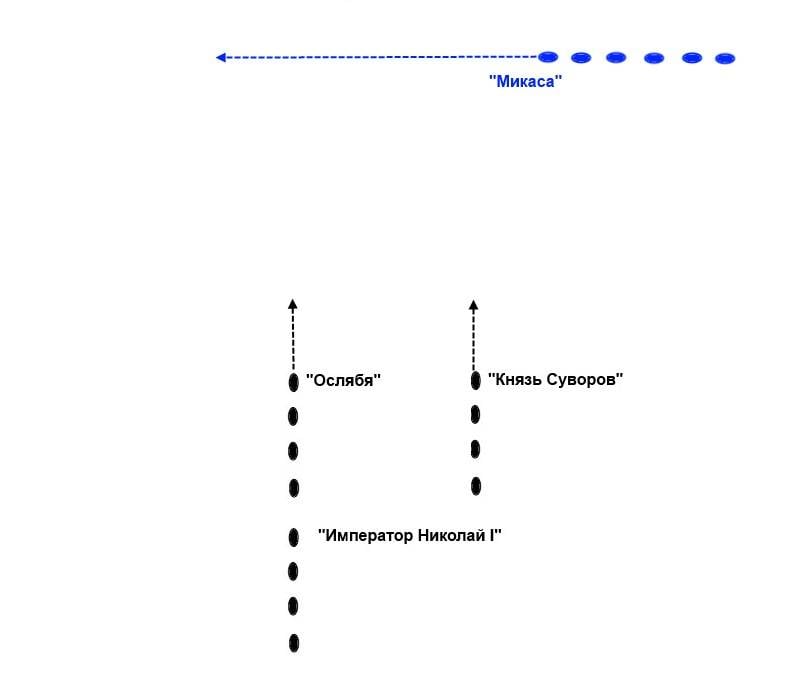
Obviously, Kh. Togo was preparing to put his plan into practice — in order to attack the left Russian column, he had to go to the left side of the Russian squadron, which he did.
Russian squadron begins rebuilding
In response to this, Z.P. Rozhestvensky immediately ordered to increase the speed of his flagship to 11,5 knots, and ordered to raise the signal to the “1 squadron - keep 11 knots.”, And immediately turned to the left: now the 1 th battle squad, turning successively, headed by “Suvorov” ", Went against the course" Oslyabi. " According to the testimony of Z.P. Rozhestvenskogo Investigation Commission, the turn was started in 13.20, and completed in 13.49 - at this moment "Prince Suvorov" entered the course "Oslyabi" and, tying to the right, headed the wake column of the main forces of the Russian squadron.
It must be said that in various, and sometimes very serious sources, the above events are described quite differently. The Japanese detection time is indicated by 13.20, but sometimes by 13.25., And the completion time of the maneuver of the 1 armor unit is from 13.40 to 13.49 minutes. Thus, according to the testimony of eyewitnesses, the maneuver execution time “jumps” from 15 to 29 minutes. There is a statement that the 1 combat unit did not turn consistently, but “all at once” on the 8 points (90 degrees) left. At the same time, an eyewitness to the events, flag-captain K.K. Clapier de Colong, in his testimony to the Investigation Commission, stated that the battleships did not turn "all at once", but consistently, and not at 8, but at 4 rumba (45 degrees). The official Russian historiography, apparently, decided to somehow reconcile these contradictory points of view, agreeing with the flag officer that the turn was at 4 rumba, but stating that it was not carried out consistently, but “all at once”. But that's not all: KK Clapier de Colong reported that the 1 armored detachment turned immediately after developing 11 knots, but the flagship mine officer Leontyev 1 th, reported that the right column, developing 11 knots, was first ahead left, and only then began to turn.
A separate issue is the distance between the left and right Russian columns, and their mutual arrangement. Z.P. Rozhestvensky argued that the distance between the columns was 8 cabling, the flagship navigator Filippovsky indicated the same distance. Rear Admiral N.I. Nebogaty practically agreed with them, reporting 7 cable. There were other similar testimonies: for example, Lieutenant Maximov from the coastal defense battleship Ushakov reported on 6-8 cable. But here, the officers of the squadron battleship "Eagle" had a different opinion and reported on 14-15 and even 20 cables, on "Sisoy Velikiy" they believed that the distance between the columns was 17 cables, etc. The same problem with the position of the columns: a series of testimonies and the official Russian story they say that by the time the Japanese appeared on the horizon, Oslyabya was on the traverse of Suvorov, but “there are opinions” that the right column had turned out to be somewhat advanced.
Thus, it is very difficult to make a consistent description of this maneuver, based on the recollections of eyewitnesses and on historical works, since the latter too contradict each other. But for the reasons that will be described below, the author sticks to the version of ZP. Rozhdestvensky.
So, in 13.20, the Russian squadron was going in two columns, the distance between which was 8 cable or so, while the Oslyabya was on the beam of the Suvorov, or slightly behind. Seeing the Japanese, "Suvorov" immediately increased the speed to 11,5 knots. and leaned to the left, but not on 4, and certainly not on 8 points, but very slightly - the change in course was less than point, about 9 degrees.
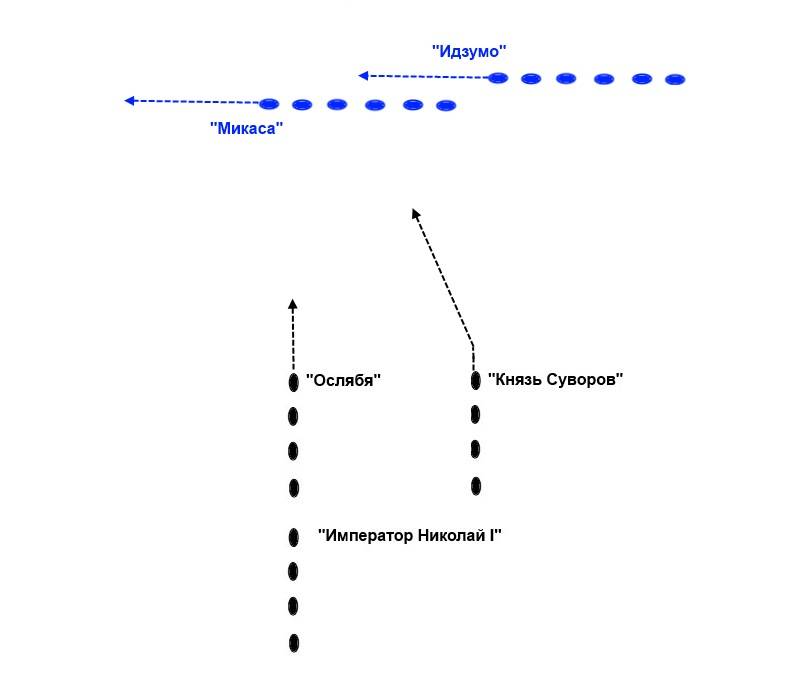
In order to build a single wake column with an 1 armored detachment led by such a turn, it took almost half an hour, but this is Z.P. Rozhestvensky quite satisfied. He needed to finish the rebuilding by the time the Japanese opened fire on the ships of the left column, and for that just about that was required. But the most important thing is that such a rebuilding, performed relatively slowly, and with a slight left turn, would be very difficult to see from the Japanese flagship.
From the perspective of the Japanese flagship, it was practically impossible to “catch” a slight increase in speed and a slight turn of the “Prince Suvorov” and the battleships following him. Thus, the Russian squadron was gradually reorganized into battle formation, but for X. Togo, the situation looked as if the Russians continued to follow the march in two columns, and did nothing. In other words, it turned out that ZP Rozhestvensky, as it were, “invited” H. Togo to rush to a relatively vulnerable left column, showing him that in this case the Borodino-type battleships would not have time to lead the Russian squadron. In fact, due to the increase in speed and rotation of the 1 armored detachment, this was not the case, because the Russians had time to complete the rebuilding.
And it turned out that if H. Togo continued his movement towards the Russian squadron, in order to crush the old ships led by the Oslyabyi on the 7 countercourse, he would soon find the wake column leading to him, leading by the best battleships of the 2 Pacific Squadron. Such a start of the battle became extremely advantageous for the Russian commander, especially since in the Russian Imperial Navy, shooting on countercourses was considered one of the most important artillery exercises.
Of course, all this was not a sentence for Kh. Togo at all. The Japanese commander, having superiority in speed and seeing that everything was not going well for him, could easily retreat, breaking the distance. But in this case, a tactical victory at this stage would be left to Z.P. Rozhdestvensky: he did not allow "crossing T" and even forced the Japanese to withdraw, what else can you demand from him? In addition, during the retreat, the Japanese fell for some time under the fire of Russian guns, being in a position that was not very favorable for them: there were chances not to drown, but at least to damage their ships. And if H. Togo was slow, or ventured to disperse on countercourses for a short distance ... Even with the disgusting quality of Russian shells, and even under the condition that H. Kamimura would not have substituted his ships for dagger fire, the passage of four battleships and Nissin with "Kasuga" along the line of 12 Russian ships, 11 of which (except for "Admiral Nakhimov") carried heavy guns, could cause very heavy damage to the Japanese.
Apparently, for the first time, the version of the “trap for X. Togo” was put forward by the respected V. Chistyakov (“A quarter of an hour for Russian guns”), and, in the author’s opinion, he was largely right. It is possible, of course, that Z.P. Rozhdestvensky was guided by somewhat different considerations than V. Chistyakov described. But the fact is that the Russian commander perfectly imagined the benefits of delaying the rebuilding of the marching order in the battle, which follows from the words of ZP himself. Rozhestvensky: the author quoted them in a previous article.
Coming to the left side of the Russian squadron, the Japanese turned around and went to the countercourse: it was because they were going to attack the relatively weak left Russian column. Here, of course, a number of readers may have a fair remark - by diverging from X. Togo’s countercurse, they would hardly have managed to completely crush the old Russian battleships with 305-mm guns, and those could well have been able to “recoup” on the relatively weakly armored cruisers of H. Kamimura. But the fact is that the Japanese squadron did not form a single wake column, the 2 th combat detachment went separately and a little to the right of the 1 th. In addition, H. Kamimura had quite broad powers, he had to act on the situation and was not obliged to follow the flagship. Thus, armored cruisers X. Kamimury could break the distance in case of divergence by the countercourse, which would minimize their risks, or even completely retreat if it becomes very hot. However, it was unlikely that all of this could have been known in the Russian squadron.
For some time, the squadrons converged on countercourses, and then the Japanese turned almost on 180 degrees - more precisely, on 15, and perhaps all the same, and all 16 points, and lay down on a course almost parallel to the Russian squadron. This maneuver was later called the “Loop of Togo”.
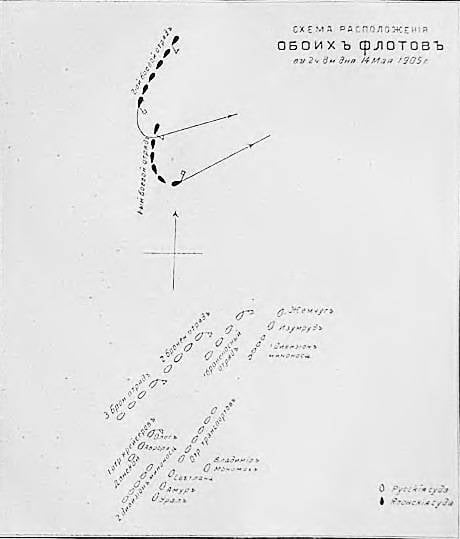
Such a turnaround, taken in view of the enemy, in any respect cannot be considered a success of Japanese tactics, because during the execution of the maneuver only deployed ships could fire, interfering with those that only went to the turning point.
After 2 minutes after “Mikasa” entered the circulation, that is, into 13.49, several events occurred simultaneously:
1. "Prince Suvorov" came to the head of the Russian squadron and turned it to the right, laying down the course NO23, which the left column followed;
2. "Mikasa" completed the turn and lay down on a new course;
3. "Prince Suvorov" reduced the speed to 9 knots. and opened fire.
This ended the pre-combat maneuvering - the main forces of the Russian and Japanese squadrons entered the battle, and the author with a clear conscience could return to the description of the history of the cruisers “Pearl” and “Emerald”. However, in order to avoid understatement, we briefly and briefly consider the consequences of the maneuvers of the opposing sides.
How strongly did the Japanese "substitute" by performing the "Noose of Togo"?
Unfortunately, the position of the turning point of the Japanese ships relative to the Russian squadron is not precisely known: eyewitnesses have a “spread” in opinions, considering that the bearing on it ranged from 8 to 45 degrees to the left. But, be that as it may, there is a completely reliable fact confirmed by the Japanese themselves - in the first 15 minutes of the battle, while Mikasa received 19 hits, including 5 * 305-mm and 14 * 152-mm projectiles, and in others Japanese fleet ships still hit at least 6 shells. Why at least? The fact is that the Japanese, of course, at the end of the battle had the opportunity to record almost all the hits to their ships, but, of course, they were far from always able to fix the time of hits. Thus, we are talking only about hits, the time of which is known for sure, but it is quite possible that there were others.
All of the above indicates a very accurate shooting of Russian ships, which it would hardly have been possible to carry out if the Japanese had made their turn at very sharp course angles. Thus, by indirect evidence it can be argued that the bearing from the “Suvorov” to the Japanese squadron was nevertheless closer to 45 degrees than to 8.
The conclusion that can be drawn from the foregoing is that the mutual position of the Russian and Japanese ships at the time of the start of the battle allowed the Russian artillerymen to achieve a large number of hits in the Japanese, that is, the “Togo Loop” was an extremely risky maneuver for them.
Why does Z.P. Rozhestvensky concentrated the entire squadron fire on the Japanese flagship?
The question is very important: didn’t the Russian admiral realize that the 12 ships would make it difficult to target each other? Of course he understood. That is why Zinovy Petrovich did not give the order to shoot at the "Mikas" throughout the squadron.
According to the testimony of numerous eyewitnesses, the signal "1" was raised on "Prince Suvorov" - he indicated the sequence number of the enemy ship on which it was necessary to concentrate the fire. Undoubtedly, it was about Mikas. But the thing is that, according to the order No. 29 of 10 in January, this signal did not concern the squadron as a whole, but only the 1 of the armored detachment. Literally, this place sounds like this:
Moreover, it is obvious from the context that a detachment means precisely one of the armored detachments, and not the entire squadron as a whole. For example, the order contains the following indication:
Thus, Z.P. Rozhestvensky ordered only four squadron battleships of the Borodino type to fire at Mikas, while the rest of the 2 armored detachments were free to choose their targets on their own.
What advantages did the Japanese admiral receive at the end of the “Loop of Togo”?
They, oddly enough, were relatively small: the fact is that from the situation in which the Japanese ships found themselves at the end of the maneuver, it was almost impossible to set the Russian “crossing T”. In other words, after the "Loop of Togo" 2-th and 3-I Pacific squadrons, although they lost the advantage of the position (and the Japanese acquired it), but at the same time occupied a position that excluded the possibility of placing them "crossing T".
The thing was that the Russian and Japanese squadrons were on courses very close to parallel ones, and the Japanese were ahead. But any attempt to turn them to the right, in order to set up a “crossing T”, could be parried in the same turn to the right of the Russian squadron. In this case, the Japanese were moving as if on the outer circumference, and the Russians - on the inside, respectively, to keep the current position, the Russians needed to travel a smaller distance than the Japanese, and this eliminated the Japanese advantage in speed.
Why ZP Rozhestvensky did not take advantage of the advantages that the "maneuver around the inner circle" gave him?
And who said that he did not use them? In 13.49, "Prince Suvorov" turned to NO23 and opened fire, and for the 15 minutes kept the same course in order to give the Russian commanders to realize the advantage of the position. Then, in 14.05 Z.P. Rozhestvensky turns the rumba to the left on 2, in order to be closer to the Japanese, but quickly realizes that this is not a good idea, and then go to the 4 rumba to the right. Thus, the combat columns of the Russians and the Japanese turned out to be on parallel courses, and the chances of the Japanese to set the “crossing T” fall to zero. They did not even try to do this, confining themselves to the fact that their 1-th combat unit was ahead of the Russian flagship, which gave the Japanese a certain advantage.
Why ZP Rozhdestvensky did not rush with his 5 relatively high-speed armadillos to the turning point of the Japanese ships in order to turn the battle into a landfill?
Such an action did not have the slightest sense for a number of reasons.
Firstly, it could not be executed on time, because taking into account the time needed for picking up and raising signals, and increasing the speed to 13-14 nodes, the Russian ships did not have time to get close to the enemy ships in a heap. Let's not forget that up to the turning point, according to Russian data, there remained about 37-38 cable, that is, about 4 miles, and it would be possible to overcome them in 15 minutes only if the Russian battleships had a speed of around 16 from the very beginning knots. Of course, they could not develop such a speed, and even if they could, they could not have done it quickly. In addition, we must not forget that, unlike successive turns, the turn “all of a sudden” required a flag signal, and it had to be dialed, lifted, waited until the ships that received the order would rehearse (that is, raise the same signals), and only then order to perform ...
Secondly, it was much more profitable to move with the previous course than to rush headlong. The fact is that moving forward at a speed of at least 9 nodes brought the Russian squadron closer to the turning point of the Japanese, and opened the best course angle to this point. In other words, by the time when the terminal Japanese ships, the weakly protected cruisers H. Kamimura, would have entered the turn, almost the entire squadron from the distance that Z.P. Rozhestvensky estimated as not exceeding 35 cables for the end of the Russian ship. At the same time, throwing forward led to the fact that the most powerful Russian battleships could operate only half of their large-caliber artillery (bow towers) and prevented the 2 and 3 armored detachments from firing.
Thirdly, after the completion of the maneuver, the “landfill” could not have turned out all the same - the relatively low-speed 1 of the Japanese detachment of Z.P. Rozhdestvensky didn’t have time to do it anyway, and the cruiser X. Kamimura had a larger course and could very quickly break the distance. But after that, the Russian squadron would have been dispersed in the 2 squad, and would have been easily defeated.
Why did the Japanese admiral start his “noose” at all?
As mentioned earlier, the Japanese commander in his report reported that, based on intelligence data, he decided to attack the left column of the Russian squadron. Obviously, for this purpose he moved from the right shell of the Russian squadron to the left. H. Togo explained his subsequent actions as follows:
It must be said that the explanation of this maneuver, which was given by Kh. Togo, is completely unsatisfactory. There was no point in “forcing the enemy to think about a countercurse.” What could be achieved by this? Only that the Russians would try to reorganize into one wake column. But if X. Togo initially conceived such a maneuver, then he should have built his maneuvering in such a way as to put a "crossing T", or to achieve another significant advantage. However, all that the Japanese commander achieved as a result of the “Loop of Togo” - turned out to be in almost parallel columns somewhat ahead of the Russian squadron - was quite achievable even without extreme turns at gunpoint of the heavy battleships of the battleships Z.P. Rozhdestvensky.
In other words, it was possible to believe the Japanese admiral that his maneuvers were part of a predetermined plan, if, as a result of their implementation, the Japanese would have a clear, tangible advantage that could not be achieved in a different way. But there was nothing of this. Therefore, it is most likely that H. Togo, going to the left shell of the Russian squadron and turning it on a countercourse, was really going to fall on its left column, believing that the battleships of the Borodino type did not have time to lead the Russian system. And when he saw that the Russians had nevertheless managed, he was forced in a hurry to urgently invent something. He probably did not dare to turn "all of a sudden", since in this case the battle control passed to his youngest flagship. There remained only a turn consistently that H. Togo executed, that is, this decision was forced for him.
Thus, it can be stated that the idea of Z.P. Rozhdestvensky was a great success - for a long time keeping the “two-column” system and rebuilding so that it was invisible from the Japanese ships, he tactically outplayed the Japanese commander, saved his squadron from the “crossing T”, provided its 15-minute advantage in the battlefield and made X. Togo to join the battle is not in the best position possible.
All of the above would have allowed the Russian commander to be considered a brilliant naval commander ... if not for the series of mistakes that Zinovy Petrovich made when implementing his own, in any respect, outstanding plan. But we will discuss this in the next article.
- Andrei from Chelyabinsk
- Jewels of the Russian Imperial Navy. Pearls and Emerald
Jewels of the Russian Imperial Navy. "Pearls" and "Emerald". Design features
Jewels of the Russian Imperial Navy. "Pearls" and "Emerald". About the quality of construction
Jewels of the Russian Imperial Navy. "Pearls" and "Emerald". Libava - Madagascar
Jewels of the Russian Imperial Navy. "Pearls" and "Emerald". Madagascar - Tsushima
Why ZP Rozhdestvensky did not use the cruiser "Pearl" and "Emerald" in Tsushima for the intended purpose?
Tsushima battle. What did Z.P. Rozhdestvensky, dividing the forces into two columns?
About the tactical advantage of speed in a naval battle, or Two knots for "crossing T"
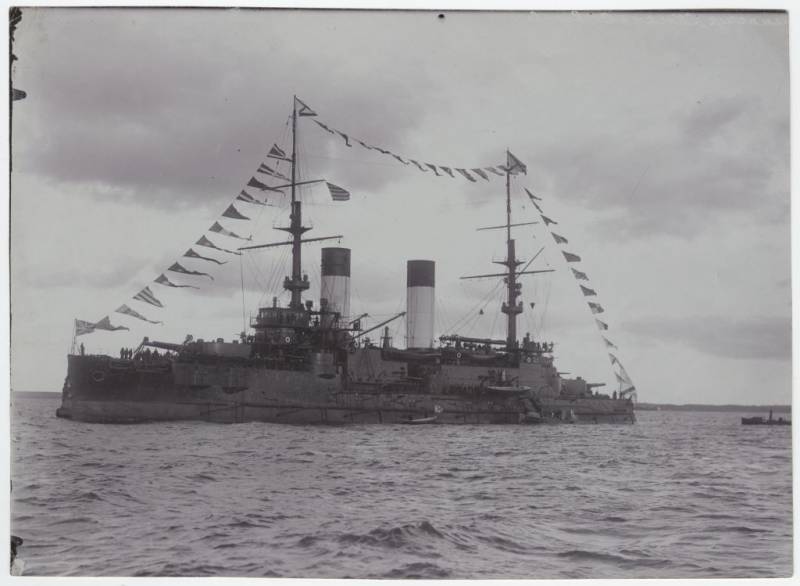
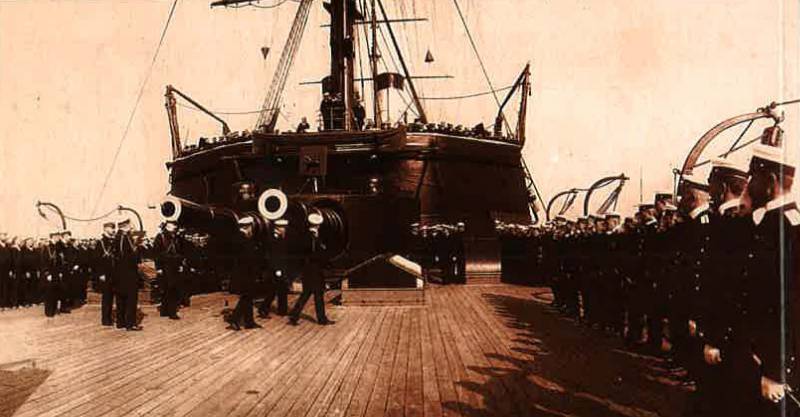
Information